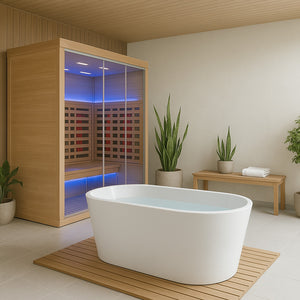In the world of athletic performance, athletes are constantly seeking new techniques to enhance recovery and maximize their performance. Contrast therapy (or hot-cold therapy) is an increasingly popular method that uses alternating cycles of heat and cold exposure to stimulate the body and aid healing. But what exactly is contrast therapy, how does it work, and what are its real benefits?
What is contrast therapy?
Contrast therapy involves alternating exposure of different body parts, typically muscles or limbs, to heat and cold. This technique, also known as contrast baths, can be performed in various ways:
- Hot and cold water baths
- Sauna or steam room followed by immersion in cold water
- Hot and cold packs applied locally to muscles
Contrast therapy is often used after intense workouts, competitions, or during post-injury rehabilitation. It combines the beneficial effects of heat and cold to boost blood circulation and enhance muscle recovery.
How does contrast therapy work?
The basic idea is to use heat and cold to trigger physiological reactions in the body:
- Heat dilates blood vessels (vasodilation), allowing better blood flow, which helps relax muscles and remove toxins accumulated during exercise.
- Cold, on the other hand, causes blood vessels to constrict (vasoconstriction), reducing inflammation, swelling, and pain by slowing down nerve responses in the treated area.
By alternating these two stimuli, a “pumping” effect is created in the tissues, stimulating circulation, improving oxygenation to the muscles, and aiding in the rapid removal of metabolic waste, such as lactic acid.
Classic phases of a contrast therapy session
- Heat exposure: for example, a bath at 38-40°C or a sauna session for 3-5 minutes.
- Cold exposure: immersion in cold water (10-15°C) or applying cold packs for 1-2 minutes.
- Repeat the cycle: hot-cold cycles are repeated 3-5 times based on goals and individual tolerance.
It is recommended to finish with a cold session to reduce inflammation after exercise.
The benefits of contrast therapy
1. Improved blood circulation
The cycles of vasodilation and vasoconstriction enhance blood circulation, allowing more oxygen to reach the muscles and promoting faster removal of toxins accumulated during exercise, thereby reducing soreness and muscle fatigue.
2. Reduction of inflammation and swelling
Cold helps reduce inflammation by limiting blood flow to the inflamed areas and slowing cellular activity. This is especially useful after intense physical effort or in the case of injuries.
3. Pain relief
Cold acts as a natural analgesic by numbing the treated area, while heat relaxes the muscles. Together, these effects quickly alleviate muscle and joint pain.
4. Accelerated muscle recovery
Athletes who regularly practice contrast therapy after training report reduced muscle soreness and faster recovery. Increased circulation and reduced inflammation help muscles repair more efficiently.
5. Reduced joint stiffness
The alternation between heat and cold improves joint flexibility and reduces stiffness, a particularly useful benefit for those suffering from chronic pain or arthritis.
6. Strengthened immune system
Thermal contrasts stimulate the immune system by increasing lymphatic circulation, thereby promoting the elimination of toxins and boosting the body’s natural defenses against infections.
7. Mental relaxation effect
The temperature changes also stimulate the nervous system, inducing overall relaxation and a feeling of well-being. This can help reduce stress, which is essential for athletes to maintain optimal focus and motivation.
Who can benefit from contrast therapy?
Contrast therapy is particularly beneficial for:
- Endurance athletes looking to speed up recovery after long, grueling races.
- Strength athletes wanting to reduce muscle soreness and inflammation after intense training sessions.
- People in rehabilitation using hot-cold therapy to alleviate chronic pain or recover from injuries.
- Fitness enthusiasts looking to maintain good blood circulation and consistent recovery.
Conclusion
Contrast therapy is a simple yet effective method to improve muscle recovery and reduce post-exercise pain. Whether you’re a professional athlete, a fitness enthusiast, or undergoing rehabilitation, incorporating hot-cold sessions into your routine could help enhance your performance and protect your body in the long term. However, it is recommended to consult a healthcare professional before adopting this technique, especially if you have cardiovascular issues or specific injuries.
Try contrast therapy and discover for yourself the benefits it can bring to your recovery routine!











